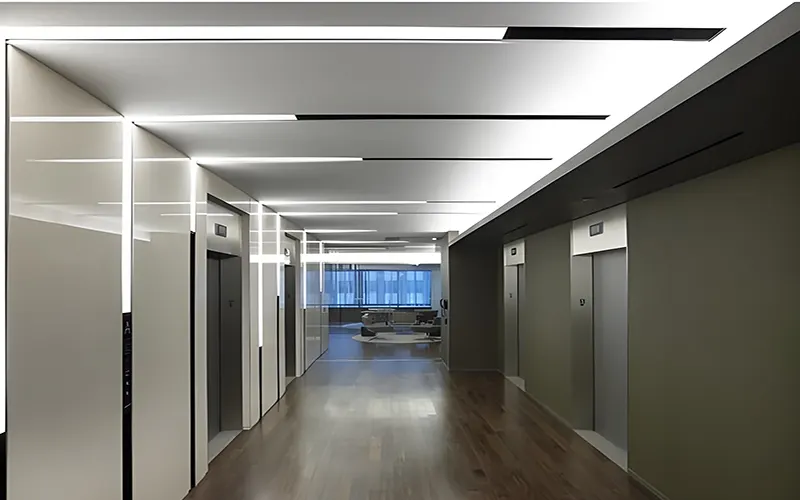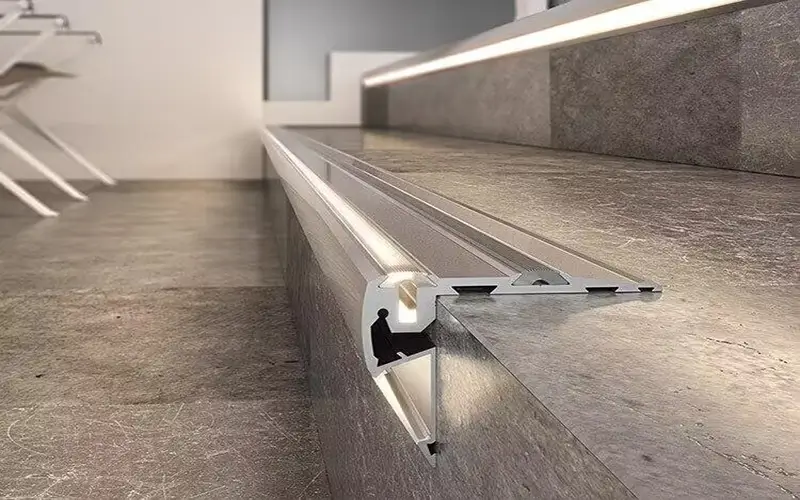
People nowadays are paying more and more attention to residential lighting systems, and LED profiles have become one of the most popular lighting decorations. Many people install LED profiles in stair lighting, which improves safety by illuminating steps and adds a touch of sophistication to the environment.
People increasingly use LED profiles in stair lighting due to their versatility, energy efficiency, and stylish design. In this comprehensive guide, we will explore LED aluminum profiles. How to integrate LED profiles into stair lighting? and a step-by-step process on how to install LED profiles into stair lighting.
What are An LED Profiles?
LED profiles are also known as LED channels and LED extrusions, which are specially designed channels or LED housings. LED profiles are mainly used to install LED strips, which can firmly fix the LED strip in place.
The main materials for LED profiles are aluminum and other durable materials. You can choose from a variety of shapes and sizes in which LED profiles can be extruded based on your project. The structure of the LED profile consists of four main components: an aluminum profile, a PC diffuser cover, an end cap, and a mounting bracket.
LED aluminum profile
The main body of the LED aluminum profile is the aluminum frame. Which is an LED aluminum profile extruded by a machine. Available in a wide variety of sizes and shapes, each aluminum profile is different in size and shape. It has a variety of models and installation types to choose from: recessed LED profiles, surface-mounted profiles, corner-mounted profiles, suspended LED profiles, etc.
LED PC Cover (LED Diffuser)
LED PC cover (LED diffusion plate) is one of the main accessories of LED aluminum profiles. It is the same set of LED aluminum materials, so it is natural to choose it. It is available in several colors: cream cover, clear cover and diffuser cover. Covers of different colors have different light transmittances. Its main function is to protect the LED light strip, improve the lighting effect of the LED light, and make the LED light distribution more uniform.
Additionally, some LED PC diffusers are now bendable and can bend into a circle, belonging to the free arc series. And some LED profile covers can only be straight.
End cap
Generally, users will match LED aluminum profiles with tail ends, leaving holes on both ends. They will equip 1 m/pc LED strips and LED aluminum profiles with two end caps. One end cap has holes for the LED strip wire to pass through, and the other end cap has no holes. Opting for a holed end allows you to connect power more easily.
Mounting clip
During installation, users need to install mounting clips, which most LED profiles come equipped with. In addition, some special LED aluminum profiles require special installation accessories, such as corner LED aluminum profiles, which you need to use special mounting brackets to fix.
What is Stair Lighting?
Stair lighting refers to the use of lighting sources to decorate stairs. It takes into account the design and safety features of the stair and aims to increase visibility and safety for those using the stair, while also enhancing the aesthetics of the stair space.
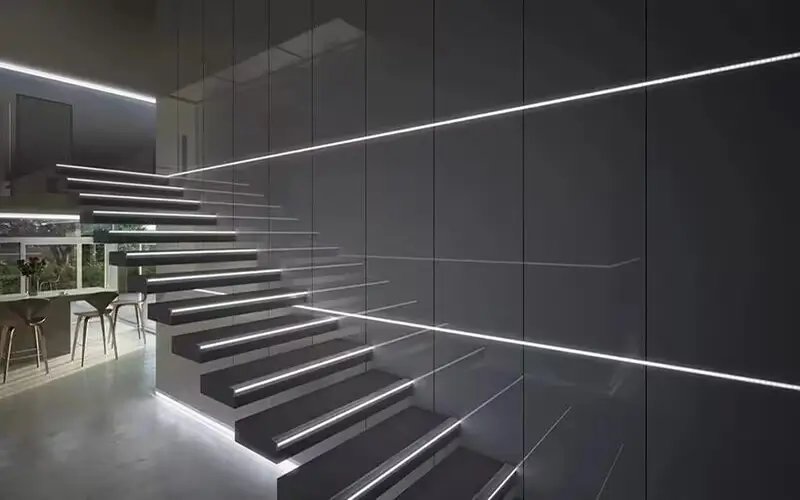
There are many ways to light stairs: users can decorate them with LED strips and LED aluminum profiles, recessed lighting fixtures, wall-mounted lights, or illuminated handrails. These lighting elements offer various integration options into staircases to provide adequate illumination and maximize safety.
Additionally, stair lighting helps enhance the aesthetics of both interior and exterior spaces. It can enhance the style of interior design, create an atmosphere, highlight architectural features, and complement the overall design plan of home and interior architecture.
What is the Function of Stair Lighting?
For interior lighting design, stair lighting is also very important. It can embellish the indoor atmosphere and also play a key role in improving safety.
- Improve safety and reduce the risk of trips and falls.
- Also illuminates dimly lit or poorly lit areas in corners.
- Enhances the visual appeal of the staircase, creates a warm atmosphere, and highlights the architectural features.
How to Choose LED Strips for Stair Lighting?
There are several important factors to consider when choosing the right LED strips for stair lighting. Thereby ensuring safety and aesthetics. Here are some key considerations:
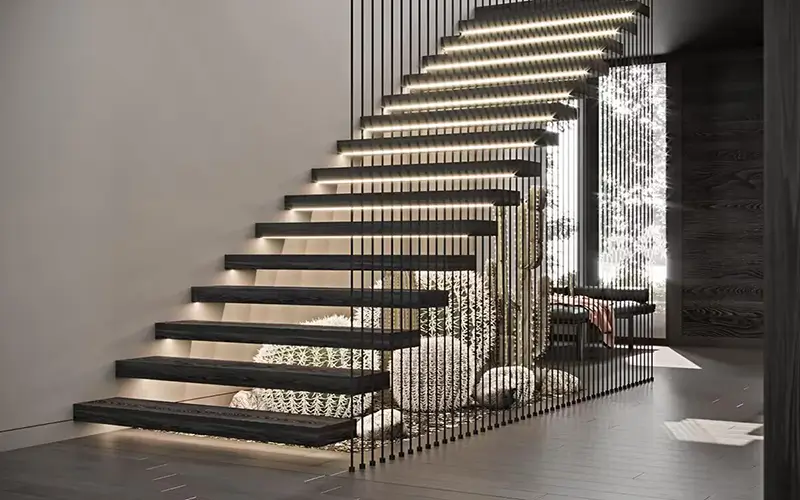
Stair brightness
Choose an LED strip with appropriate brightness. It has enough brightness to illuminate the plastic staircase, but it should not be too dazzling and should make people look comfortable.
Color temperature
LED strips come with a variety of color temperatures, from warm white to cool white, even RGB, and RGBW. It is necessary to choose a color temperature that blends with the overall atmosphere of the space while providing sufficient visibility on the stairs.
Color Rendering Index (CRI)
CRI measures the ability of a light source to accurately render colors compared to natural sunlight. Choose LED light strips with high CRI to ensure the colors appear vivid and true, preferably CRI90 or above.
Versatility
Consider the flexibility and size of LED strips, as stairs mostly feature curved and irregular surfaces, and flexible LED strips can adapt to a variety of shapes and angles, making them suitable for complex installations.
Which LED Profiles Can be Used for Stair Lighting?
There are many types of LED profiles suitable for stair lighting: recessed profiles, surface-mounted profiles, and suspended profiles. Each has unique advantages, depending primarily on the purpose of your stair design and lighting preferences. The following are installation recommendations:
Recessed LED Profiles for stair lighting
Recessed LED profiles are the preference of many people. You can install the LED profiles flush with the stair surface, providing a clean and minimalist look. They are ideal for stairs where space is limited, and the recessed profiles help prevent tripping hazards and integrate seamlessly with the stair design.
Surface Mount LED Profiles stair lighting
These LED profiles mount on the surface of the stairs for versatility and ease of installation. Surface-mounted profiles come in a variety of shapes and sizes and can be mounted underneath each flight of stairs. They are suitable for use on stairs where recessed installation is not possible or when retrofitting existing stairs with LED lighting.
Suspended LED profiles stair lighting
Suspended LED profiles are installed on the ceiling or wall above the stairs. The light from above can be indirectly projected onto the plastic surface of the building, creating a softer, more diffuse light. This can not only improve safety visibility but also create a warm atmosphere.
How to Install LED Profiles to Stair Lighting?
How to install LED profiles in stair lighting requires careful planning, precise measurements, and correct execution to achieve the best results. You can refer to the following steps:
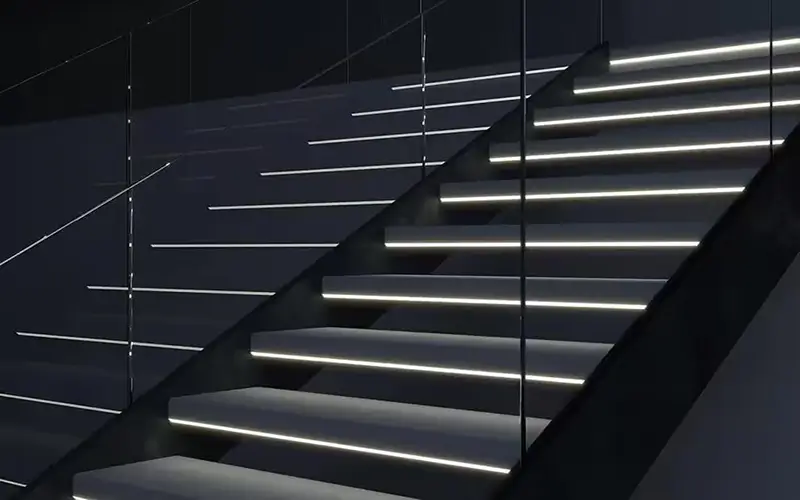
Preparation before installation
Assess your stair layout and determine the best location for LED profiles. Measure the length of each stair tread and riser where the LED profile will be installed. Take precise measurements to ensure your LED strips fit perfectly.
Measuring the LED profile
It is best to measure the length of the LED profile and customize the length. You don’t need to cut to length yourself.
Install the LED profile
Securely secure the LED profile to the stairs using mounting brackets or adhesive backing. Make sure the profiles are level and properly aligned along the length of the stairs.
Attach the LED light strip
Carefully pass the LED light strip through the channel of the LED profile according to the position of the LED profile. Avoid excessive bending or curling of LED strips to prevent damage to the LEDs or wires.
Connect the LED strip
Use wire connectors to secure connections and ensure proper conductivity. Then connect the LED strip to the power supply.
Test lighting
Before permanently affixing LED profiles, test lighting to ensure all LED strips are working properly and producing the desired lighting effect.
Secure Wiring
Once you have tested that the LED strip is OK, use cable clamps or zip ties to secure the wiring and cables to prevent them from hanging loose or getting tangled.
Complete the installation
Secure the LED profiles in place using screws or mounting hardware to ensure they are stable and secure. Before completing the installation, carefully check the alignment and positioning of the LED profiles.
How to Maintain Stair Lighting?
Regular maintenance is essential to keep your stair lighting in top condition. Clean your LED profiles and LED strips regularly to remove dust, dirt, and debris that may have accumulated over time so that it does not affect their brightness and functionality.
Additionally, wiring and fixtures need to be inspected for signs of wear or damage, and any issues addressed promptly to prevent breakdowns or safety hazards.
Summarize
Installing LED profiles for stair lighting is a practical and stylish way to enhance the safety and ambience of your residential or commercial space. You can learn about the structure of LED profiles, the functions of stair lighting, and how to select and install LED profiles. You can create a well-lit and visually appealing staircase that enhances the overall beauty of your environment.
Regular maintenance at the same time ensures that your stair lighting remains efficient and reliable for years to come. You can achieve stunning stair lighting effects that transform your staircase into a focal point of your space. We are an LED profiles manufacturer; please contact us if any needs.
FAQs
To install LED profiles for stair lighting, first plan the layout, where you need to install the LED profiles, and what effect you want. Then choose the LED dynamic profile with the appropriate installation method.
Yes, it is best to measure and plan the length yourself in advance. Directly customize the length of the LED profile so you don’t need to cut it yourself.
It mainly depends on what type of installation type of LED profile you want. Generally, installation accessories are used for firm installation. You need to ensure that the profiles are level and correctly aligned along the length of the staircase.
Yes, but you need to choose waterproof LED profiles. Waterproof LED profiles are resistant to moisture and can be used in outdoor stair lighting applications. If it is not waterproof, water will enter the LED profile and burn out the LED light strip.
When choosing LED light strips for stair lighting, you should consider the brightness, color temperature, flexibility, waterproofing and other factors of the stairs you want to install. The main thing is to choose the right LED light strip according to your own needs.


